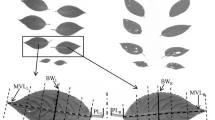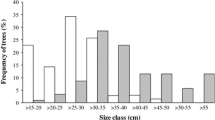Summary
Patterns of growth, reproduction, defense (leaf resin) and herbivory were compared between the sexes of the dioecious shrub Baccharis halimifolia (Compositae). Male plants possessed longer shoots and more tender leaves, grew faster, and flowered and senesced earlier than female plants. Levels of leaf nitrogen, water content, and acetone-soluble resin (shown to deter feeding by polyphagous insect herbivores) did not differ between male and female plants. When offered a choice between leaves from male and female plants, adults of two leaf beetles (Chrysomelidae), the monophagous Trirhabda bacharidis and the polyphagous Paria thoracica, both preferred to feed on male leaves. Similarly, the daily fecundity of older females of T. bacharidis was higher when they were fed leaves from male compared to female plants. However, adult survivorship and total fecundity of T. baccharidis did not differ between male and female leaf treatments. We attribute the feeding preference for and slight increase in fecundity on male plants to the tenderness of male leaves. Larvae of the fly Tephritis subpura (Tephritidae) fed exclusively in the sterile receptacle of male flower heads (85% infested), but the phenology was such that pollen production was not adversely affected. Larvae of two other flies Dasineura sp. and Contarinia sp. (Cecidomyiidae) occupied >95% of only female flower heads where they fed among and on the developing seeds. We conclude that foliage-feeding herbivores are unlikely candidates to explain the female-biased sex ratio (59% female) of B. halimifolia plants in the field, and that their preference for male plants is a result of plant characteristics (e.g. rapid growth) that have been selected by some other factor. However, our data on selective floral herbivory in B. halimifolia are in accord with the argument that dioecy reduces the inadvertent loss of flower parts of one sex when herbivores feed on flower parts of the opposite sex.
Similar content being viewed by others
References
Baker HG (1959) Reproductive methods as factors in speciation in flowering plants. Cold Spring Harbor Symp Quant Biol 24:177–190
Bawa KS (1980) Evolution of dioecy in flowering plants. Ann Rev Eco Syst 11:15–39
Bawa KS, Opler PA (1978) Why are pistillate inflorescences of Simarouba glauca eaten less than staminate inflorescences? Evolution 32:673–676
Bierzychudek P (1981) The demography of jack-in-the-pulpit, a forest perennial that changes sex. Ph. D. Dissertation, Cornell University, Ithaca, New York
Bierzychudek P, Eckart V (1988) Spatial segregation of the sexes of dioecious plants. Am Nat 132:34–43
Bullock S (1984) Biomass and nutrient allocation in a neotropical dioecious palm. Oecologia 63:426–428
Carlquist S (1974) Island Biology. Columbia Univ. Press, New York
Charnov EL (1982) The theory of sex allocation. Monograph in population biology, Vol. 18, Princeton University Press, Princeton, New Jersey
Coley PD, Bryant JP, Chapin FS (1985) Resource availability and plant antiherbivore defense. Science 230:895–899
Cook OF (1914) Sexual inequality in hemp. J. Heredity 5:203–206
Cox PA (1981) Niche partitioning between the sexes of dioecious plants. Am Nat 117:295–307
Cox PA (1982) Vertebrate pollination and the maintenance of dioecism in Freycinetia. Am Nat 120:62–80
Cronquist A (1980) Vascular flora of the Southeastern United States. University of North Carolina Press, Chapel Hill, North Carolina
Danell K, Elmqvist T, Ericson L, Salomonson A (1985) Sexuality in willows and preference by bark-eating voles: defence or not? Oikos 44:82–90
Dawson TE, Bliss LC (1989) Patterns of water use and the tissue water relations in the dioecious shrub, Salix arctica: the physiological basis for habitat partitioning between the sexes. Oecologia 79:332–343
Feeny P (1970) Seasonal changes in oak leaf tannins and nutrients as a cause of spring feeding by winter moth caterpillars. Ecology 51:565–581
Feeny P (1976) Plant apparency and chemical defense. Recent Adv Phytochem 10:1–40
Freeman DC, Klickoff LG, Harper KT (1976) Differential resource utilization by the sexes of dioecious plants. Science 193:597–599
Freeman DC, Harper KT, Charnov EL (1980) Sex change in plants: Old and new observations and new hypotheses. Oecologia 47:222–232
Fryxell PM, Lukefahr MJ (1967) Hampea Schlect. Possible primary host of the Cotton Boll Weevil. Science 155:1568–1569
Gagné R (1989) The plant-feeding gall midges of North America. Cornell University Press, Ithaca, New York
Hancock JF, Bringhurst RS (1980) Sexual dimorphism in the strawberry Fragaria chiloensis. Evolution 34:762–768
Horwitz W (1965) Official methods of analysis of the association of official agricultural chemists, 10th edition. AOAC, Washington, D.C.
Jenkins J, Turner WJ (1990) Revision of the Baccharis infesting (Asteraceae) fruit flies of the genus Tephritus (Diptera: Tephritidae) in North America. Ann Entomol Soc Am (in press)
Johnson WT, Lyon HH (1976) Insects that feed on trees and shrubs. Comstock Associations, Cornell University Press, Ithaca, New York
Kraft S, Denno RF (1982) Feeding responses of adapted and nonadapted insects to the defensive properties of Baccharis halimifolia L. (Compositae). Oecologia 52:156–163
Krischik VA (1984) The role of temporal and spatial variability in leaf nitrogen, water, toughness and resin content in the interaction between Trirhabda bacaridis (Weber) (Coleoptera: Chrysomelidae) and its host Baccharis halimifolia L. (Compositae). Ph. D. Dissertation, University of Maryland, College Park, Maryland
Krischik VA, Denno RF (1983) Individual, population, and geographic patterns in plant defense. In: Denno RF, McClure MS (eds) Variable Plants and Herbivores in Natural and Managed Systems. Academic Press, New York, pp 463–512
Krischik VA, Denno RF (1990) Differences in response to nutrient and moisture availability between the sexes of the dioecious shrub, Baccharis halimifolia (Compositae). Oecologia 83:176–181
Lloyd DG, Webb CJ (1977) Secondary sex characters in seed plants. Bot Rev 43:177–216
Lovett Doust J, O'Brien G, Lovett Doust L (1987) Effects of density on the secondary sex characteristics and sex ratio in Silene alba (Caryophyllaceae). Am J Bot 74:40–46
Mattson WJ Jr (1980) Herbivory in relation to plant nitrogen content. Ann Rev Ecol Syst 11:119–161
McKey D (1979) The distribution of secondary compounds within plants. In: Rosenthal GA, Janzen DH (eds) Herbivores. Academic Press, New York, pp 59–133
McNeill S, Southwood TRE (1978) The role of nitrogen in the development of insect/plant relationships. In: Harborne JB (ed) Biochemical Aspects of Plant and Animal Coevolution. Academic Press, New York, pp 78–98
Meagher TR (1980) The population biology of Chamaelirium luteum, a dioecious lily I. Spatial distribution of males and females. Evolution 34:1127–1137
Meagher TR (1981) Population of Chamaelirium luteum, a dioecious lily II. Mechanism governing sex ratios. Evolution 35:557–567
Meagher TR (1984) Sexual dimorphism and ecological differentiation of male and female plants. Ann Missouri Bot Gard 71:254–264
Mooney HA, Gulman SL, Johnson ND (1983) Physiologicalconstraints on plant chemical defenses. In: Hedin PA (ed) Plant Resistance to Insects. ACS Symp. Ser. 208, Amer Chem Soc, pp 21–34
Neverova LA (1971) Sootnosenie raznopolych osobej i soderzania v nich tanidov u nekotorych vidov ivy v okrestnostjach Ural'ska. Rast. Resursy 7:77–80
Onyekweln SS, Harper JL (1979) Sex ratio and niche differentiation in spinach (Spinacia oleracea L.). Nature 282:609–611
Polhemus DA (1988) Intersexual variation in plant bug densities (Hemiptera: Miridae) on Juniperus scopulorum. Ann Entomol Soc Amer 8:742–747
Policansky D (1981) Sex choice and the size advantage model in jack-in-the-pulpit (Arisaema triphyllum). Proc Natl Acad Sci USA 78:1306–1308
Policansky D (1982) Sex change in plants and animals. Ann Rev Ecol Syst 13:471–495
Price PW (1983) Hypotheses on organization and evolution in herbivores in herbivorous insect communities. In: Denno RF, McClure MS (eds) Variable Plants and Herbivores in Natural and Managed Systems. Academic Press, New York, pp 559–596
Putwain PD, Harper JL (1972) Studies in the dynamics of plant populations. V. Mechanisms governing the sex ratio in Rumex acetosa and Rumex oncetosella. J Ecology 60:113–129
Raupp M (1985) Effects of leaf toughness on mandibular wear of the leaf beetle, Plagiodera versicolor. Ecol Entomol 10:73–79
Raupp M, Denno RF (1983) Leaf age as a predictor of herbivore distribution and abundance. In: Denno RF, McClure MS (eds) Variable Plants and Herbivores in Natural and Managed Systems. Academic Press, New York, pp 91–124
Rhoades DF (1979) Evolution of plant chemical defense against herbivores. In: Rosenthal GA, Janzen DH (eds) Herbivores. Academic Press, New York, pp 3–54
Rhoades DF, Cates RG (1976) Toward a general theory of plant antiherbivore chemistry. In: Wallace JW, Mansell RL (eds) Biochemical Interaction between Plants and Insects. Recent Adv Phytochem 10:68–21
Rodriguez E, Towers GHN, Mitchell JC (1976) Biological activities of sesquiterpene lactones. Phytochem 15:1573–1580
Rosenthal GA, Janzen D (1979) Herbivores: Their interaction with secondary plant metabolites. Academic Press, New York
Ross MD (1970) Evolution of dioecy from gynodioecy. Science 24:827–828
SAS Institute Inc (1985) SAS users guide (1985) Cary, North Carolina: SAS Institute Inc.
Swain T (1979) Tannins and lignins. In: Rosenthal GA, Janzen DH (eds) Herbivores: Their interaction with secondary plant chemicals. Academic Press, New York, pp 657–682
Tanton MT (1962) The effect of leaf toughness on the feeding of the larvae of the mustard beetle Phaedon cochleariae Fab. Entomol Exp Appl 5:74–78
Wallace CS, Rundel PW (1979) Sexual dimorphism and resource allocation in male and female shrubs of Simmodsia chinensis. Oecologia 44:34–39
Waser NV (1984) Sex ratio variation in populations of a dioecious desert perennial, Simmondsia chinensis.Oikos 42:343–348
Whitham TG, Mopper S (1985) Chronic herbivory: Impacts of architecture and sex expression of pinyon pine. Science 228:1089–1090
Williams LH (1954) The feeding habits and food preferences of the Acrididae and the factors which determine them. Trans. Royal Entomol Soc London 105:423–454
Willson MF (1979) Sexual selections in plants. Am Nat 113:777–790
Willson MF, Burley N (1983) Mate Choice in Plants: Tactics, Mechanisms, and Consequences. Princeton University Press, Princeton, New Jersey
Author information
Authors and Affiliations
Rights and permissions
About this article
Cite this article
Krischik, V.A., Denno, R.F. Patterns of growth, reproduction, defense, and herbivory in the dioecious shrub Baccharis halimifolia (Compositae). Oecologia 83, 182–190 (1990). https://doi.org/10.1007/BF00317750
Received:
Accepted:
Issue Date:
DOI: https://doi.org/10.1007/BF00317750




